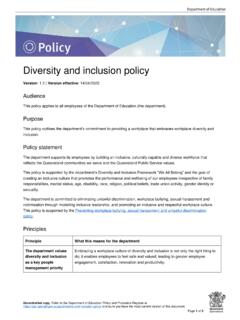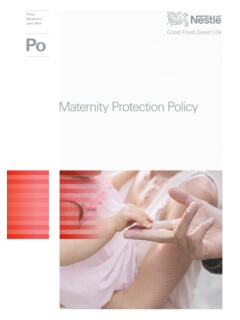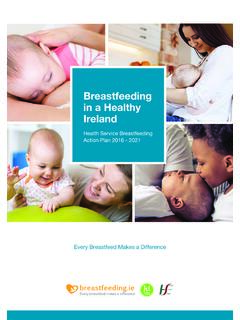Transcription of Support for Breastfeeding in the Workplace
1 Support for Breastfeeding in the Workplace Definition Support for Breastfeeding in the Workplace includes sev- eral types of employee benefits and services,20,21 including writing corporate policies to Support Breastfeeding women;. teaching employees about Breastfeeding ; providing designated private space for Breastfeeding or expressing milk; allowing flexible scheduling to Support milk expression during work; giving mothers options for return- ing to work, such as teleworking, part-time work, and extended maternity leave; providing on-site or near-site child care; providing high-quality breast pumps; and offering professional lactation management services and Support . Rationale Mothers are the fastest-growing segment of the labor force.
2 Approximately 70% of employed mothers with children younger than 3 years work full One-third of these mothers return to work within 3 months after birth and two-thirds return within 6 Working outside the home is related to a shorter duration of Breastfeeding , and intentions to work full time are significantly associated with lower rates of Breastfeeding initiation and shorter Low-income women, among whom African American and Hispanic women are overrepre- sented, are more likely than their higher-income counterparts to return to work earlier and to be engaged in jobs that make it challenging for them to continue Given the substantial presence of mothers in the work force, there is a strong need to establish lactation Support in the Workplace .
3 Barriers identified in the Workplace include a lack of flexibility for milk expression in the work schedule, lack of accommodations to pump or store breast-milk, concerns about Support from employers and colleagues, and real or perceived low milk 27. Support for Breastfeeding in the Workplace 7. Evidence of Effectiveness Cohen et examined the effect of corporate lactation programs on Breastfeeding behavior among employed women in California. These programs included prenatal classes, perinatal counseling, and lactation management after the return to work. About 75% of mothers in the lactation programs continued Breastfeeding at least 6 months, although nationally only 10% of mothers employed full-time who initiated breast- feeding were still Breastfeeding at 6 months.
4 Participants in the Mutual of Omaha's lactation program breastfed an average of months, although nationally only 29% of mothers were still Breastfeeding at 6 Both of these programs are promising but may represent unique populations that may not be generalizable to all working mothers. Indicators of satisfaction and perceptions related to Workplace programs have been evaluated, as have assessments of the use of resources for Breastfeeding Support , services provided, and perceived impact on success. Measures of participant satisfaction and perceptions show a positive impact of Workplace Support programs on the mother's work Further, several studies indicate that Support for lactation at work benefits individ- ual families as well as employers via improved productivity and staff loy- alty; enhanced public image of the employer; and decreased absenteeism, health care costs, and employee ,32.
5 Description and Characteristics Support programs in the Workplace have several components. Many factors, such as how many women need Support and the resources available, help determine the most appropriate components for a given setting. An outline document developed by the United States Breastfeeding Committee discusses adequate, expanded, and comprehensive Support for breast- feeding in the According to Bar-Yam,33 essential elements of a successful Workplace program are space, time, Support , and gatekeepers. Ideally, a Nursing Mother Room (NMR) is centrally located with adequate lighting, ventilation, privacy, seating, a sink, an electrical outlet, and possibly a Employers can use many different strategies to ensure time for Breastfeeding or milk expression, including flexible work schedules and locations, break times for pumping, and job sharing.
6 8 The CDC Guide to Breastfeeding Interventions Mothers who continue Breastfeeding after return- ing to work need the Support of their coworkers, supervisors, and others in the Workplace . Individual employers can do a great deal to create an atmo- sphere that supports employees who breastfeed. Such an atmosphere will become easier to achieve as Workplace Support programs are promoted to diverse employers. Workplace Support programs can be promoted to employers, including managers of human resources, employee health coordinators, insurers, and health providers serving many of a particular organization's employees. Program Examples Employer Recognition In 1998, the Oregon Department of Human Services Health Division developed the Breastfeeding Mother Friendly Employer Project to recognize employers who are already Breastfeeding friendly and to encourage other Oregon employers to Support Breastfeeding in the Workplace .
7 The division gives a certificate to all employers who docu- ment that they meet Breastfeeding Mother Friendly Employer criteria and publishes a list of these employers each year. Employer Incentives and Resources The Health Resources and Services Administration Maternal and Child Health Bureau has launched a national Workplace initiative that includes developing a resource kit for employers. The Business Case for Breastfeeding , developed to address barriers and the educational needs of employers, includes materials for upper management, human resource managers, and others involved in implementing on-site programs for lactation Support . Also included is a tool kit with reproducible templates that can be adapted to the work setting.
8 An outreach marketing guide helps local Breastfeeding advocates and health professionals effectively reach out to employers. Support and Accommodation in the Workplace In 2002, the Arizona Department of Health Services adopted a breast- feeding policy for all of its employees. The goal is to provide a positive work environment that recognizes a mother's responsibility to both her job and her child when she returns to work by acknowledging that a woman's Support for Breastfeeding in the Workplace 9. choice to breastfeed benefits the family, the employer, and society. 34 New mothers returning to work at the Department may be initially authorized to bring their infants to work until the child is 4 months old.
9 This period may be extended in 1-month increments, depending on job performance and the infant's activity level. The policy provides for the privacy of mother and infant, requires the mother to maintain her performance on the job, and seeks to prevent disruption of other employees' work. A designated Breastfeeding coordinator informs employees of the policy , provides educa- tional materials, and gives Support to any employee expressing an interest in Breastfeeding her infant. The California Public Health Foundation WIC (Special Supplemental Nutrition Program for Women, Infants, and Children) agencies provide a Breastfeeding Support program for their employees, most of whom are paraprofessionals.
10 The program includes encouraging and recognizing Breastfeeding milestones and providing training on Breastfeeding , monthly prenatal classes, postpartum Support groups, and a supportive work site environment. The work site environment includes pumping facilities, flex- ible break times, and access to a breast pump. A program hallmark is access to an experienced colleague known as a Trained Lactation Coach, or TLC, who breastfed her own children after returning to work. An evaluation of the California program revealed that more than 99% of employees returning to work after giving birth initiated Breastfeeding , and 69% of those employ- ees breastfed at least 12 months. Access to breast pumps and Support groups were significantly associated with the high Breastfeeding duration Over the past decade, many companies and organizations have imple- mented lactation programs.

















